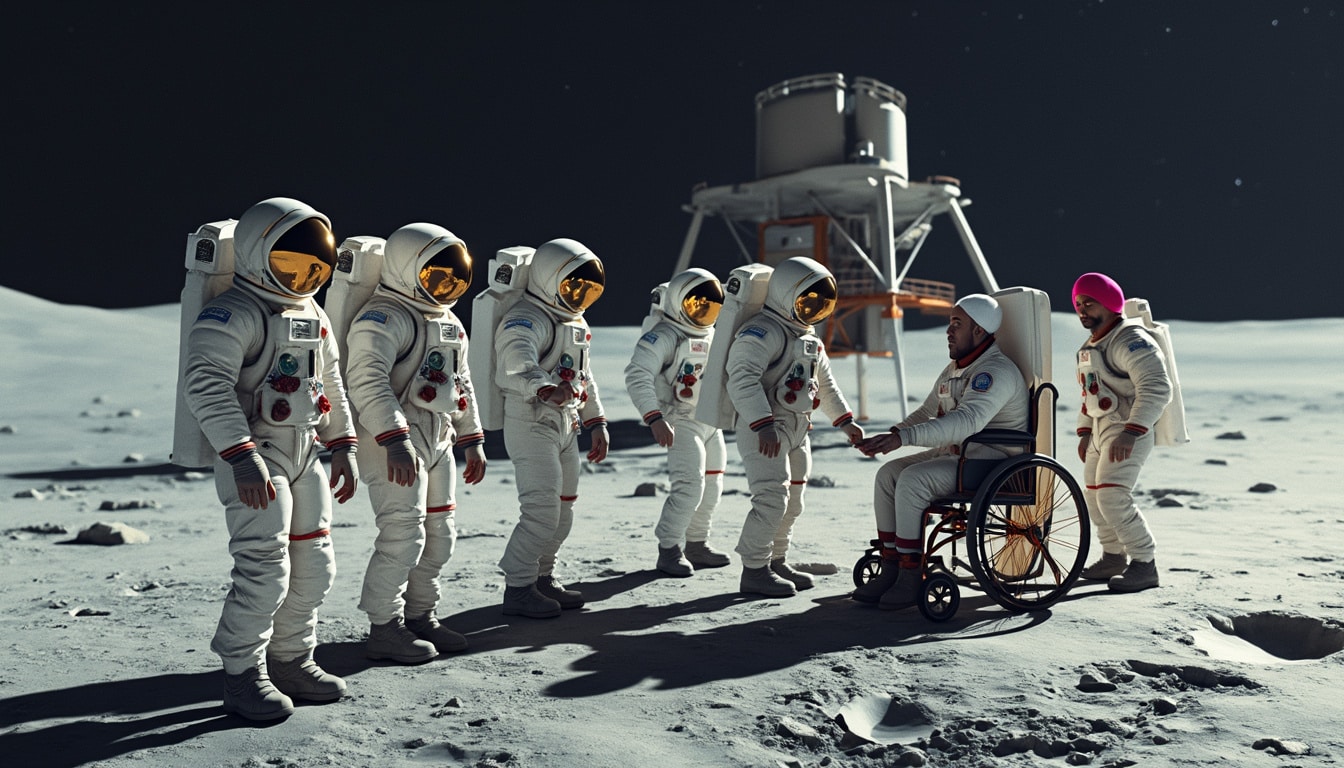In a groundbreaking collaboration that intertwines space exploration and societal change, SpaceX has garnered a crucial contract aimed at advancing NASA’s Artemis program. This initiative not only marks a significant milestone in human spaceflight but also places emphasis on diversity in a traditionally homogenous field. Amidst ongoing debates surrounding diversity, equity, and inclusion (DEI) initiatives in federal programs, Elon Musk’s SpaceX is set to play a vital role in sending the first woman and the first person of color to the moon, a mission that is both ambitious and historic.
Musk’s approach to DEI has become a focal point of discussion as he spearheads government efficiency efforts, reportedly eliminating wasteful spending on diversity programs within federal agencies. This juxtaposition creates a unique narrative, where the drive for inclusivity is challenged while simultaneously being propelled into the cosmos through groundbreaking contracts with NASA. The ongoing intricacies of such dynamics provide fertile ground for exploring the nuances of leadership, government policy, and the future of space exploration.
Unveiling the Artemis Program and SpaceX’s Role
The Artemis program stands as NASA’s ambitious initiative to return humans to the Moon for the first time since the Apollo missions, with aspirations stretching towards Mars. Launched under the directive of the Trump administration in 2017, the program aims to land astronauts on the lunar surface, where they will conduct extensive scientific research and pave the way for future exploration. This includes plans for long-term human presence on the Moon, focusing on scientific discovery and international partnerships.
Central to this mission is SpaceX, which won a $2.9 billion contract to develop the Human Landing System (HLS) that will transport astronauts to the Moon. Specific designs and operational processes are being tailored to support the missions, ensuring that they can safely land on the lunar surface and efficiently return to orbit.
SpaceX’s selection for such a role reflects not only its advanced technology but also its innovative approach to reducing costs and increasing efficiency—a key factor in modern space exploration. With multiple contracts in place, the projected financial obligations for SpaceX’s ventures under Artemis could reach $4.4 billion.

Key Historical Aspects of Space Exploration
The history of space exploration has often been marked by both triumph and controversy, predominantly overshadowed by a lack of representation and diversity. The Apollo missions, while monumental, primarily featured white male astronauts. This historical precedent has raised significant concerns about inclusivity in scientific fields and led to intense discussions surrounding DEI efforts in various sectors.
NASA has expressed a commitment to rectifying this imbalance through the Artemis program. The crew selected for the upcoming Artemis missions includes notable figures such as Navy Captain Victor Glover and NASA astronaut Christina Koch, representing a new era in which diversity is not merely an afterthought but a core principle guiding explorative efforts in space.
This evolution is encouraging, signaling a positive shift towards inclusivity and social responsibility, paired with the technical prowess and innovative spirit characteristic of SpaceX projects. The integration of diverse perspectives is expected to enrich the missions’ objectives and outcomes, culminating in a reformative approach to human spaceflight.
SpaceX’s Contract in the Context of DEI Initiatives
The current landscape surrounding DEI initiatives within federal environments has become contentious, particularly under Elon Musk’s recent doctrine as he leads efforts to eliminate what he regards as unnecessary spending related to diversity. His Department of Government Efficiency is described as executing a stringent examination of federal agencies, ostensibly to ensure fiscal responsibility by slashing DEI programs deemed ineffective.
This directive raises questions about the commitment to diversity within organizations that intersect with SpaceX and NASA. Despite the broader political dialogue surrounding DEI, the selection of a diverse crew for Artemis reflects a crucial commitment to representing various demographics in space exploration.
However, challenges remain. While SpaceX secures substantial contracts and advances its objectives in space, the implications of Musk’s policies on DEI could potentially overshadow the positive strides made within NASA. The concern persists that as efficiencies are mandated, underlying principles supporting diversity might diminish, creating friction between operational goals and broader societal values.
Elon Musk’s statements emphasizing that “DEI must die” introduce complexity into this narrative. Critics and supporters alike grapple with the potential ramifications of such ideologies on the mission of sending diverse astronauts to the Moon, exploring whether successes in space exploration can indeed coexist with stringent cuts to DEI initiatives aligned with Musk’s leadership style.

The Implications of Space Contracts on Future Missions
Space contracts with NASA have historically enabled advancements not only in technology but also in fostering relationships across various sectors, propelling exploratory ambitions for humanity into the furthest reaches of space. The Artemis program has leveraged these partnerships, illuminating the intricate dance between governmental priorities and private sector innovation.
In a rapidly evolving sector, SpaceX’s success hinges on its ability to not only fulfil government contracts but also adapt and innovate. As they gear up for the upcoming missions, the pressure mounts to deliver operational excellence and safety, particularly considering the mission’s historical significance.
Ensuring the successful execution of lunar landings will set the stage for future Martian exploration as well, pushing the boundaries of what is achievable through human endeavor. As these missions unfold, the spotlight on SpaceX’s strategies and operational methodologies will become a pivotal study for future missions, potentially serving as a benchmark for how public-private partnerships can elevate space endeavors.
Comprehensively, the partnership with NASA is a testament to the credibility and capability of SpaceX, validating Musk’s vision of increased accessibility to space for diverse groups. Characterizing the upcoming missions as merely a branding opportunity, however, oversimplifies their deeper significance in reshaping societal narratives around inclusion and technological advancement.
The Future of DEI in Space Exploration
The future landscape of DEI in the realm of space exploration remains uncertain yet full of potential. As larger societal conversations continue to unfold regarding diversity, equity, and inclusion, the impact of these discussions on the space sector cannot be overlooked. Developing a culture that prioritizes inclusivity is crucial for fostering innovation and enhancing team performance in exploratory missions.
Moving forward, organizations such as SpaceX and NASA must navigate the challenging waters where operational efficiency and dedication to diversity intersect. The ramifications of policy changes and leadership ideologies will resonate throughout various projects, influencing how space exploration is perceived and executed in the coming decades. Igniting progressive conversations around DEI may cultivate a rich environment where diversity is celebrated and fostered, paving the way for future generations of astronauts and space scientists.
As the Artemis missions advance and culminate in historic lunar landings, the space community should remain vigilant in ensuring that the strides toward inclusivity are not only recognized but also integrated into future exploration endeavors.

Strategies for Enhancing DEI in Space
To sustainably enhance DEI within the space exploration community, various strategies can be implemented. Focused recruitment efforts targeting underrepresented communities can substantially broaden the talent pool, ensuring that diverse perspectives are included in all aspects of space missions. Establishing mentorship programs, scholarships, and educational partnerships aimed at fostering interest in STEM among youth will cultivate a future generation equipped to engage in explorative careers.
Moreover, transparent discussions about the importance of diversity in the workplace can serve to align operational goals with broader social values. Quality training on unconscious bias and inclusive practices will also fortify an organization’s commitment to fostering an inclusive atmosphere.
Ultimately, the combination of these strategies will contribute to a paradigm shift where diversity is seamlessly integrated into the ethos of organizations like SpaceX and NASA, enhancing their capabilities as they navigate the cosmos.










Leave a Reply